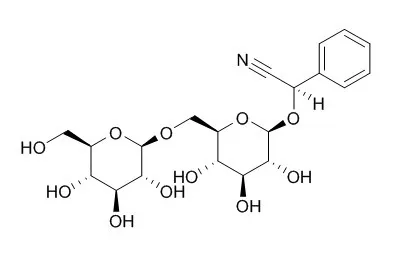| Cell Research: |
| Yao Xue Xue Bao. 2014 Aug;49(8):1136-42. | | The synergistic effect of amygdalin and HSYA on the IL-1beta induced endplate chondrocytes of rat intervertebral discs.[Pubmed: 25322555] | The effect of Amygdalin joint hydroxysafflor yellow A (HSYA) on the endplate chondrocytes derived from intervertebral discs of rats induced by IL-1beta and the possible mechanism were studied and explored.
METHODS AND RESULTS:
Chondrocytes were obtained from endplate of one-month SD rat intervertebral discs and cultured primary endplate chondrocytes. After identification, they were divided into normal group, induced group, Amygdalin group, HSYA group and combined group. CCK-8 kit was adopted to detect the proliferation of the endplate chondrocytes. FCM was measured to detect the apoptosis. Real-time PCR method was adopted to observe the mRNA expression of Aggrecan, Col 2 alpha1, Col 10 alpha1, MMP-13 and the inflammatory cytokines IL-1beta. The protein expression of Col II, Col X was tested through immunofluorescence. Compared with the normal group, the proliferation of the endplate chondrocytes decreased while the apoptosis increased (P < 0.05). With down regulation of the mRNA expressions of Aggrecan, Col 2 alpha1 and up regulation of the mRNA expressions of Col 10 alpha1, MMP-13, IL-1beta (P < 0.05), the protein expression of Col II decreased while the protein expression of Col X increased. Compared with the induced group, Amygdalin group, HSYA group, the combined group could inhibit the apoptosis and promote the proliferation (P < 0.05). They could increase the mRNA expressions of Aggrecan and Col 2 alpha1 while decrease the mRNA expressions of Col 10 alpha1, MMP-13 and IL-1beta (P < 0.05). They could also enhance the protein expression of Col II while reduce the protein expression of Col X.
The effect of the combined group was significantly better than that of Amygdalin and HSYA.
CONCLUSIONS:
Amygdalin joint HSYA could inhibit the degeneration of the endplate chondrocytes derived from intervertebral discs of rats induced by IL-1beta and better than the single use of Amygdalin or HSYA. | | Immunopharmacol Immunotoxicol. 2013 Feb;35(1):43-51. | | Amygdalin induces apoptosis in human cervical cancer cell line HeLa cells.[Pubmed: 23137229] | Amygdalin, a naturally occurring substance, has been suggested to be efficacious as an anticancer substance.
The effect of Amygdalin on cervical cancer cells has never been studied.
METHODS AND RESULTS:
In this study, we found that the viability of human cervical cancer HeLa cell line was significantly inhibited by Amygdalin. 4,6-Diamino-2-phenyl indole (DAPI) staining showed that Amygdalin-treated HeLa cells developed typical apoptotic changes. The development of apoptosis in the Amygdalin-treated HeLa cells were confirmed by double staining of Amygdalin-treated HeLa cells with annexin V-FITC and propidium iodide (PI) along with increase in caspase-3 activity in these cells. Further studies indicated that antiapoptotic protein Bcl-2 was downregulated whereas proapoptotic Bax protein was upregulated in the Amygdalin-treated HeLa cells implying involvement of the intrinsic pathway of apoptosis. In vivo, Amygdalin administration inhibited the growth of HeLa cell xenografts through a mechanism of apoptosis.
CONCLUSIONS:
The results in the present study suggest that Amygdalin may offer a new therapeutic option for patients with cervical cancer. |
|






 Cell. 2018 Jan 11;172(1-2):249-261.e12. doi: 10.1016/j.cell.2017.12.019.IF=36.216(2019)
Cell. 2018 Jan 11;172(1-2):249-261.e12. doi: 10.1016/j.cell.2017.12.019.IF=36.216(2019) Cell Metab. 2020 Mar 3;31(3):534-548.e5. doi: 10.1016/j.cmet.2020.01.002.IF=22.415(2019)
Cell Metab. 2020 Mar 3;31(3):534-548.e5. doi: 10.1016/j.cmet.2020.01.002.IF=22.415(2019) Mol Cell. 2017 Nov 16;68(4):673-685.e6. doi: 10.1016/j.molcel.2017.10.022.IF=14.548(2019)
Mol Cell. 2017 Nov 16;68(4):673-685.e6. doi: 10.1016/j.molcel.2017.10.022.IF=14.548(2019)